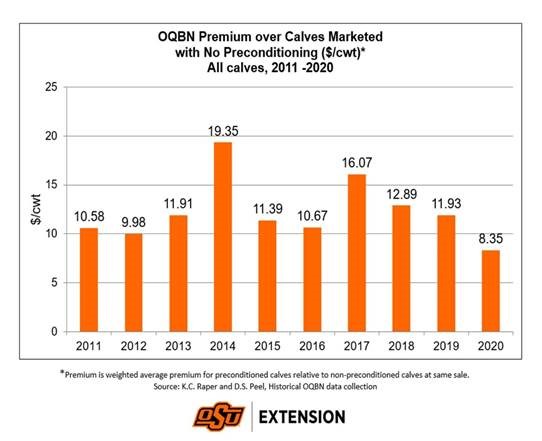Oklahoma Quality Beef Network 2020 Sale Summary

The COVID-19 virus over the past year has produced several disruptions sending the country into lockdown, thus causing a shift in the retail beef sector with higher demand at the grocery store. Virus outbreaks in packing plants further compounded the problem. Supply issues were eventually remedied, and things were back to business as usual…for the most part. If anything, it exposed the vulnerability in our supply chain and the need for more diversity at the packer level.
No doubt, industry issues, and the virus continued to linger on in the minds of many producers. A dry fall and slow wheat availability around the state contributed in delaying stocker buyers from ramping up purchasing. Add in the fact it was also a presidential election year, and the combination of everything left many producers waiting to see how things were going to play out.
During the 2020 fall selling season, the Oklahoma Quality Beef Network (OQBN) participated in six livestock markets (Cherokee, Woodward, McAlester, Payne Co., Southern Plains, and OKC West) where producers participated in 14 sales beginning mid-October ’20 and finishing the first week of February ‘21. Producers enrolled 4,655 head from across 39 counties in Oklahoma, Texas, Kansas, and Colorado. Data was collected on 2,224 head at 9 sales. Producers received an average premium of $8.35/cwt (the first chart shows the premiums by year for steers and heifers combined) over non-preconditioned calves. Steers had average premiums of $8.68/cwt and heifers $7.88/cwt (shown in the second chart).
Needless to say, 2020 did not prove to be a favorable year for the cow/calf producer. OQBN sales were no exception. Though producers still saw premiums over non-preconditioned calves, the data collected displayed irregularities not seen in a typical year. For example, 5-weight steers brought premiums of $5.43/cwt on average. This is a considerable decrease from years past that averaged $12.59/cwt over a 5-year span. Compare that to 3, 7, and 8-weight steers that averaged $18.07, $11.43, and $10.98/cwt, respectively over non-preconditioned cattle.
A logical explanation for 7 and 8-weight steer receiving higher premiums could be due to the shortened grazing season due to the late wheat, and buyers were looking for steers that would be feedlot ready coming off pasture. Cattle in the 3-weight class saw the highest premiums with steer receiving premiums of $18.07/cwt and heifers $15.59/cwt. It is likely buyers saw these lightweight preconditioned cattle as a nice opportunity to add a lot of pounds without the cost and time of backgrounding these calves in a drylot since they would be ready to turn out on pasture. Premiums received for 3-weight calves might look enticing, but the seller should also consider whether the 3-weight premium outweighs the value in added pounds by holding cattle longer.
Evidence shows preconditioning calves in a down market does provide added value and squeezing out every penny is more important than ever. However, producers should pay close attention to cost of inputs in order to maximize profit per head. Any anticipated premiums can quickly be erased if one fails to properly track input costs, particularly in feeding cattle. Proper planning is key in any preconditioning program and determining your break-even price a useful way to identify when and how you will market your calves. Tools for calculating cost of gain and break-even pricing can be found at www.beef.okstate.edu .









